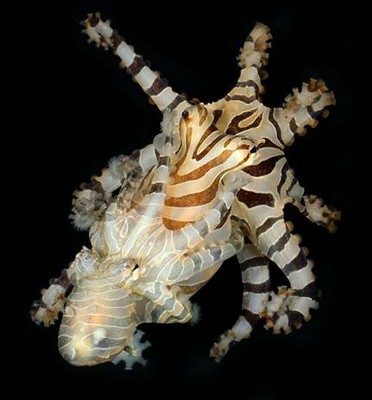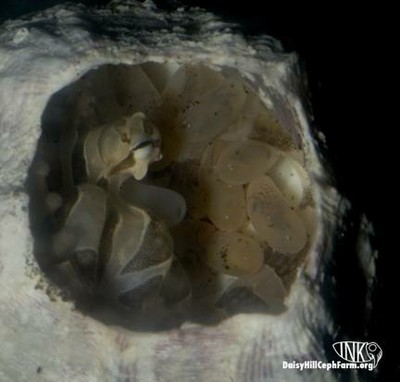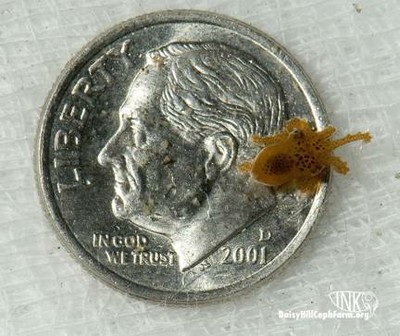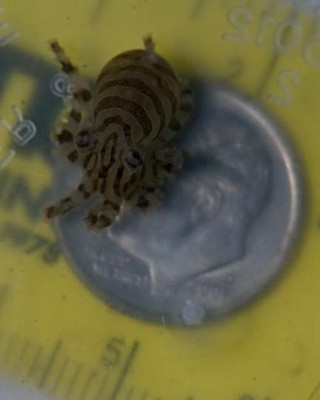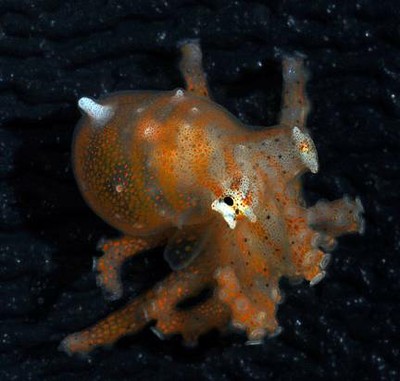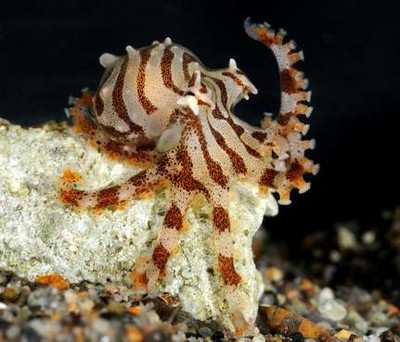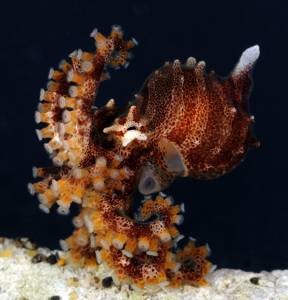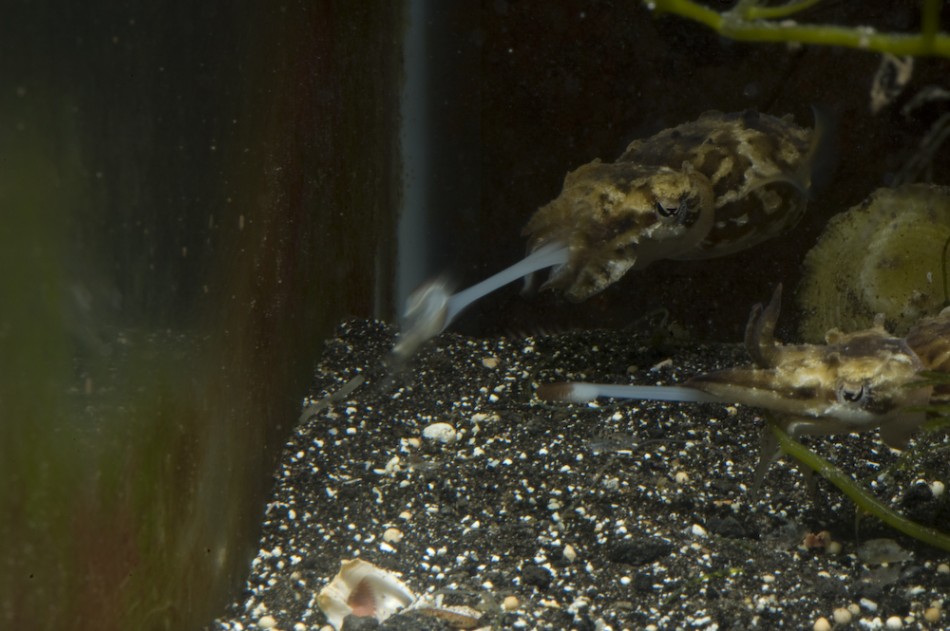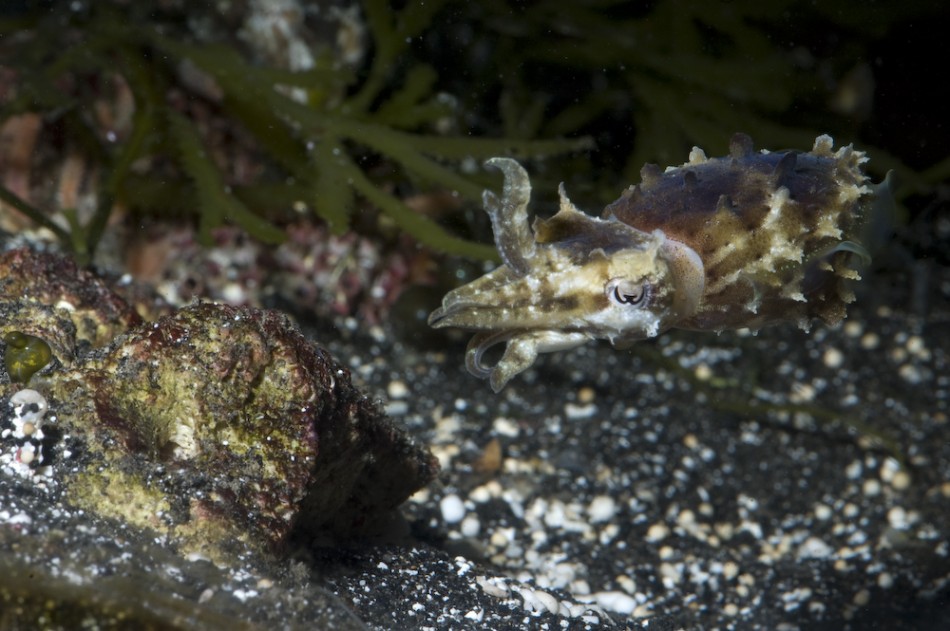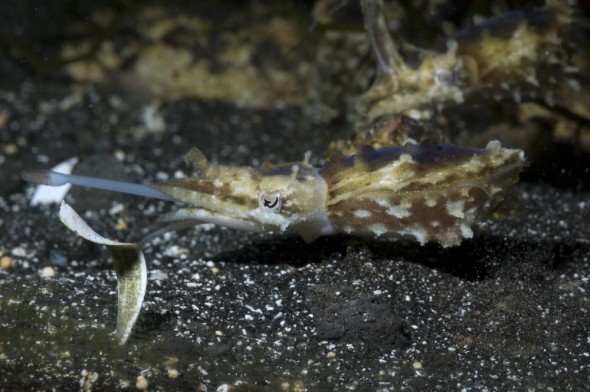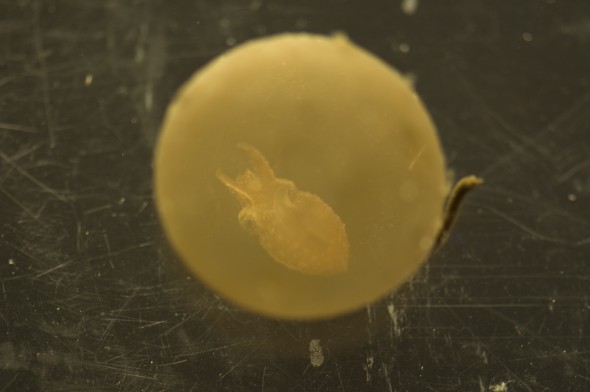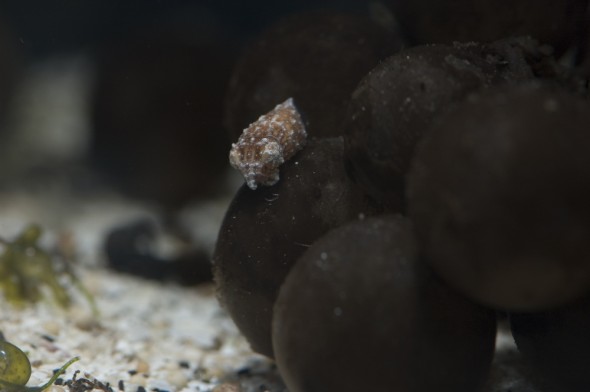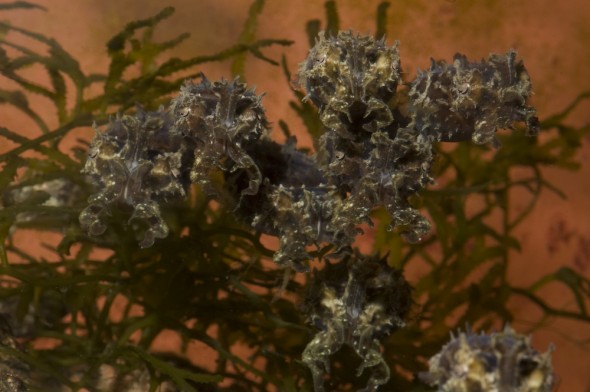Aquarium Invertebrates: Metasepia pfefferi – the aptly named Flamboyant Cuttlefish
From Advanced Aquarist Online and Reef Life Magazine.
The Flamboyant cuttle is one of the most amazing animals I have encountered in the wild or in captivity. They are beautiful, masterful predators that live fast and die young. It is my hope that one day they will be bred in captivity and readily available for all cephalopod enthusiasts.
Cuttlefish are the artists of the sea. . They float through the water like oceanic ballet dancers. Their feeding tentacles shoot forward with a speed, accuracy and control that would make a martial artist weep. One minute they have the color and texture of a smooth rock; the next they flash complex three dimensional patterns and suddenly resemble a monster out of Greek myth. While all cuttlefish share these abilities, there is one species that takes these arts to an apex, making the rest look like dull amateurs – the aptly named Flamboyant Cuttlefish.

The Flamboyant cuttlefish, Metasepia pfefferi, is an astonishing little animal found primarily in muck habitats. These vast, rolling underwater plains of settled silt and mud appear desolate at first glance, but are in fact populated by an unexpectedly large number of strange animals including frogfish, ghost pipefish and a stunning array of nudibranchs. Fitting right in with these odd neighbors, the Flamboyant is normally a master of camouflage blending in completely with the grey substrate. When startled, however, those previously subdued colors change to bright purples, reds, yellows and whites. The colors shine out in coruscating patterns along the animal’s body.
Flamboyants are incredibly bold, even when startled, and will hold their ground while putting on their color show for an amazingly long time. These fantastic displays have helped make ‘muck’ diving popular, have put Flamboyant cuttlefish on the top of underwater photographer/videographers “must shoot list” and have made them a pined-for-but-rarely-obtained aquarium specimen.
What’s in a name?
The ‘Flamboyant’ part of the common name is easy to understand, but the ‘cuttle’ or the ‘fish’ part might be a little less straightforward.
The origins of the word ‘cuttlefish’ or ‘cuttle’ have not been been nailed down. According to cephalopod researcher John W Forsythe, “The name Cuttlefish originally came about as the best guess of how to spell or pronounce the Dutch or perhaps Norwegian name for these beasts. It is derived from something like ‘codele-fische’ or ‘kodle-fische’. In German today, cuttlefish and squids are called tintenfische, meaning ‘ink-fish’. I’ve been told that the term fische actually refers to any creature that lives in the sea or are caught in nets when fishing, not just fishes. Anyway, that’s what I understand the derivation of name to be.”
Recently there has been a movement, at least in public aquariums, to make the names of certain animals more ‘correct’ to avoid confusion. For instance, neither Jellyfish nor Starfish are fish, thus they are now referred to as Jellies and Sea Stars respectively. Perhaps it is time to refer to cuttlefish as cuttles, because they aren’t fish at all. Cephalopod researcher Dr. James Wood sums it up clearly; “Octopuses, squids, cuttlefish and the chambered nautilus belong to class Cephalopoda, which means ‘head foot’. Cephalopods are a class in the phylum Mollusca which also contains bivalves (scallops, oysters, clams), gastropods (snails, slugs, nudibranchs), scaphopods (tusk shells) and polyplacophorans (chitons)”, however unlike their relatives, cephalopods move much faster, actively hunt their food, and seem to be quite intelligent.”
Nuts and bolts
There are actually two species in the Metasepia genus, Metasepia pfefferi, the Flamboyant cuttlefish, sometimes referred to as Pfeffer’s Flamboyant cuttlefish, found from the Indonesia to northern Australia to Papua New Guinea, and Metasepia tullbergi, the Paint pot cuttlefish, found from Hong Kong to southern Japan. Both species are small, having a mantle length of 6-8 centimeters, with the females’ being larger than males. Distinguishing the species visually is difficult, and telling them apart relies on subtle differences in the animals’ cuttlebones.
Metasepia, like all cephalopods, have three hearts (two branchial or gill hearts, and systemic heart that pumps blood through the rest of the body), a ring shaped brain, and blue, copper based blood. They have 8 arms, with two rows of suckers along each arm, and two feeding tentacles tipped with a tentecular club. The shafts of the feeding tentacles are smooth, while the grasping face of the club is covered with suckers, some of which are proportionally huge. The tentacles and tentecular club shoot forward to snare prey and pull it back to the arms. Once gripped by the arms, the preyis manipulated to a beak-like mouth and a wire brush like tongue called a radula, both of which help reduce the prey to appropriate size to be eaten. Reducing the food size is critical because the esophagus actually runs through the middle of the cuttle’sring shaped brain; swallowing something too big might damage the brain.
The Flamboyant’s striking color changes are accomplished by organs in the skin called chromatophores The chromatophores are neurally controlled and allow for instant color changes over the entire skin of the cuttlefish by triggering muscles to change the amount of pigment that is displayed. The skin patterns aren’t necessarily static either, they can move, like animation on a TV screen, and are thought to aid in communication, hunting and camouflage. This is evidenced on the dorsal surface of the mantle where violet stripes can often be seen pulsing across the white areas Metasepia.


In addition, to evade predators or hide from prey, Flamboyants can also change the shape of their skin by manipulating papillae across their bodies to break up their body outline. The larger papillae on the top side of the Flamboyant cuttlefish’s mantle don’t change at all.
Flamboyants use a three-tiered approach for movement. They have a fin that girds their mantle that allows for fine movement, and they can use jet propulsion via water pumped over the gills and through their funnel, which allows for surprisingly fast movement. Most amusingly, Flamboyant cuttles often amble or walk across the substrate using their outside pair of arms and two lobes on the underside of their mantle as ‘legs’. In my experience, Metasepia prefer this walking to swimming and only leave the substrate when extremely threatened or are overly harassed by groups of divers overzealously trying to get the perfect photo.
One of the most well known features of cuttles is the cuttle bone, which is often used by pet owners to provide calcium for caged birds. Cuttlefish use this multi chambered internal calcified ‘shell’ to change buoyancy by quickly filling or emptying the chambers with gas. Interestingly, while the cuttle bone of most cuttles is as long as the animal’s mantle, the diamond shaped cuttlebone of the Flamboyant is disproportionately small, thin, and only 2/3 to ¾ of the mantle length. The small size of the cuttlebone may make swimming difficult and may accounts for the Flamboyants preference to ‘walk’ along the bottom.


Like other cephalopods, Flamboyant cuttles can also produce copious amounts of ink if startled. It is thought that the ink acts as a smokescreen to allow the cuttlefish to escape predation, but most of the Metasepiainking events I have seen have been more along the lines of ‘pseudomorphs’, or blobs of ink that are thought to further aid in escape from predation by presenting the predator with multiple targets.
Toxicity
Recent research by cephalopod researcher Mark Norman, as reported in the episode of the television series NOVA – Kings of Camouflage, takes a step at explaining the weird colors, the fearlessness, and walking behaviors of the of the flamboyant cuttlefish.
According to Norman “Well, it turns out the flamboyant cuttlefish is toxic. It’s as toxic as blue-ringed octopuses. And blue-ringed octopuses have killed humans from their bites, so we’ve got the first deadly cuttlefish in the world. And it’s amazing on a couple of levels. First of all, it’s actually poisonous flesh, the muscles themselves are poisonous. So this is the first time that flesh that is deadly has been reported in any of these groups of animals. And secondly, the toxin itself is not known. It’s some completely different class of toxins. And toxins like those could be the key to whole new discoveries for lots of human medical conditions… This is a fantastic result, because it makes sense of what we’re seeing in the wild. And this toxicity, this poisonousness is probably what’s underpinning the whole weird behavior of the animal. And the fact that a group of animals that normally swim around or spend a lot of time trying to be camouflaged, have become so obvious, have given up swimming, are walking everywhere, it’s like a major step towards a whole new line in the evolution of these animals.”
It is also possible the bite and ink of the Flamboyant contains toxins, so any handling of these animals should be taken with a good deal of caution and forethought.
Lifecycle
Metasepia begin life as tiny eggs laid in crevices or under overhangs or sometimes hidden inside a sunken coconut husk. The eggs are laid individually, and are approximately 8 mm in diameter. Unlike some cuttlefish species, the female does not incorporate ink into the egg mass, so the egg appears to be white or translucent. This makes it easy to see the developing cuttle inside., Hatchlings are roughly 6mm in length at hatching and are miniature versions of adults. These are instant predators ready to get out into the world and start changing colors and eating a diet of mostly small crustaceans, stomatopods and sometimes fish.

Like all cephalopods, Metasepia grow very quickly and can reach adult size somewhere between 4 and 6 months after hatching.Adult female Metasepia are larger than males, reaching 8 centimeters in mantle length while males top off at less than 4-6 centimeters in mantle length; this may account for the size discrepancy in descriptions of these animals. Like most cuttles, Metasepia mate by coupling head to head. The male deposits a packet of sperm called a spermatophore, via a groved arm called a hectocotylus into a pouch in the female’s mantle. The mating is very fast, the male darting in, making his deposit, and darting away, perhaps due to the threatening size difference of the mates.
Metasepia have a lifespan of about a year, and the end can be ugly as the animal enters into what is known as senescence. Motor control begins to fail, lesions can appear on the skin, and the cephalopod seems not to care about anything, including food or having arm tips eaten by bristleworms or hermit crabs.
Keeping Metasepia: Ethical considerations
The idea of keeping the more exotic cephs – Wunderpus photogenicus, Thaumoctopus mimicus, and bothMetasepia spp – has generated much discussion in cephalopod circles, mostly because the size and health of their wild populations is unknown. Even the sharing of information, photos or video of these animals in captivity can be controversial. Some fear that detailed information and attractive photos may encourage inexperienced saltwater aquarists to obtain specimens and encourage over-collection, perhaps impacting the ability of wild populations to recover.
Personally, believe that the admiration of a species can be of benefit to its preservation in the wild rather than its detriment. Experienced cephalopod keepers can and have made positive additions to the overall knowledge about these animals. My hope is that the open sharing of information empowers aquarists to make sound, rational decisions regarding the advisability of keeping these animals.
Keeping Metasepia is not something that should be entered into on a whim and even experienced cephalopod keepers with mature tanks should think long and hard before obtaining this species. Their needs are resource intensive, specific, and not yet fully understood, so if you do decide to take give it a go, take your time and please document your efforts so others can learn from your successes and mistakes.
Getting an animal
The biggest drawback to keeping any cephalopod in aquaria is getting one. Cephalopods are notoriously terrible shippers, often arriving at their destination dead in a bag of ink-filled water. This may have to do with an inherent inability of the animal to deal with the stress of shipping, or it may be because the time and effort needed to ship these animals successfully is not well understood. Either way, currently importers are wary of ordering these animals because of their poor survival rate through the chain of custody.
The aquarium trade does not distinguish between the Metasepia species, and if you are lucky enough to find one, and willing to pay between 300 and 800 dollars US per animal, you really can’t be sure which species you have. I do think that most of the animals that make it into the trade are actually Metasepia tullbergi from Japan where they have been tank raised. Metasepia pfefferi, to be best of my knowledge, have not tank been tank raised anywhere.
What’s even worse about trying to obtain one of these animals for your aquarium is the idea that most of the animals imported are single adult males, which means they may only live for weeks or months and there is no possibility of eggs or breeding. Over the past 7 years I have been able to obtain 3 live Metasepiaspecimens, once driving from San Francisco to Los Angles and back in the same day to give the animal every chance to survive. All were adult males and lived between 2 and 4 months.
Husbandry
A mature aquarium with stable reef like water quality is necessary for housing Metasepia. Water temperature should be approx 78f (25.5c), salinity 33.5-34.5 ppt, pH 8.1-8.4, with ammonia, nitrite and nitrate as close to 0 as possible. Ammonia seems to be particularly problematic for cephalopods so regular testing and an ‘ammonia alert’ card are useful to determine the frequency of needed water changes.
A good skimmer is necessary to provide oxygen and nutrient export as well as to provide “insurance” for any inking events. Carbon, along with mixed and heated saltwater for water changes is good to have on hand as well for any inking. A good amount of live rock and/or macro algae is a good “bonus” for filtration and shelter.
A substrate area of at least 36×12 inches (standard 30 gallon breeder aquarium) is recommended to provide enough ‘walking’ room for a single animal. I prefer to use a muck substrate substitute like Carib-Sea mineral mud, in combination with 4×6 inch sections of any of the ‘mud’ products available, but since Metasepia don’t dig, a fine sand bottom will also work adequately.
Simple fluorescent lighting is enough for the Metasepia, though something more powerful may be necessary if keeping macro algae or simple non-stinging (Discosoma, Nepthea, Xenia etc) corals along with the cephalopod. High intensity lighting should be fine as these animals are diurnal.
When possible, I like to keep my cephalopod tanks plumbed into a larger reef system. This allows for a larger overall water volume, more stable water conditions and alleviates the need for extra equipment. SinceMetasepia don’t escape from aquariums like their octopus cousins, a tight fitting lid isn’t needed and plumbing into an existing system is easy. Best of all, a tank plumbed into a larger system can be taken off line and put on line very quickly given the availability of Metasepia.
I prefer to not keep any other fish or ceph with the Metasepia. Either the Metasepia will eat the fish or the fish will harass the Metasepia. In reality, these animals are so rare in the trade that I am an advocate of anything that gives them a better chance at survival… which means avoiding annoying tank mates. Clean up crew animals such as snails, hermit crabs in moderation, and bristle worms won’t be eaten by the Metasepia, and will help clean up any uneaten food.
If the Flamboyant arrives in good condition, it may start eating right away – the three I have been able to obtain over the years have eaten within minutes of being released into the aquarium. Metasepia seem to need to eat more than other cuttles, and I suggest feeding them at least 3 times a day. If the animal doesn’t get enough food, it may begin to float at the surface and not be able to fully submerge; it seems lack of food may be related to poor buoyancy control. I have heard accounts of the backs of under-fed Metasepia actually drying out from the animal not being able to get away from the water’s surface.
Almost any live shrimp will be eaten with gusto. I have used live and frozen saltwater ghost shrimp(Palaemontes Vulgaris) and local San Francisco bay bait shrimp (Cragnon spp) with great success. Start with live and then experiment with thawed frozen because one of the most important things you want from a newly imported Metesepia is to get the cuttle eating. Live crabs seem less interesting to Metasepia than to other cephalopods, and thawed frozen krill has been flatly ignored.
Late Breaking News
After 8 years of fruitless effort, I was able to obtain a group of Metasepia for captive breeding at the Steinhart Aquarium in the California Academy of Sciences. While the group suffered 80% loss in the first week, 90% in the first month, we were able to mate one male with several females which then laid eggs. Some of the eggs have developed, and at the time of writing, we have two hatchling Metasepia and several more eggs developing. This is a good, but baby step on the road to being able to keep and breed these animals in captivity. I am working hard to keep the hatchlings alive.
What this experience tells me is that even with all the resources of a Public Aquarium, wild caught, adult Metasepia are difficult to keep alive for any length of time. However, the small success means there is hope on the horizon for studying, appreciating, and breeding this amazing cephalopod in captivity.
Conclusion
The Flamboyant cuttle is one of the most amazing animals I have encountered in the wild or in captivity. They are beautiful, masterful predators that live fast and die young. It is my hope that one day they will be bred in captivity and readily available for all cephalopod enthusiasts.
If you are interested in keeping cephalopods, there are several species that are easily available, better understood and make better starter cephs than Metasepia. Please do some reading on www.TONMO.combefore purchasing any cephalopod.
References and other sources of Information
Hard Copy:
- Dunlop, C and King, N. 2008. Cephalopods: Octopuses and Cuttlefish for the Home Aquarium. TFH Publications. 269 pages
- Hanlon, RT and Messenger. 1996. Cephalopod Behaviour. Cambridge University Press. 232 pages
- Jereb, P. and Roper, C.F.E. (editors). 2005. Cephalopods of the world. Issue 4, Volume 1, FAO. PP 60-62
- Norman, Mark. 2000. ‘Cephalopods a world guide’. ConchBooks : pp.86-89
- Nesis, KN. 1987. Cephalopods of the World. TFH publications. 351 pages
Web:
- Nova, Kings of Camouflage; http://www.pbs.org/wgbh/nova/transcripts/3404_camo.html
- Wood, J and Jackson, K, How Cephalopods Change Color;http://www.thecephalopodpage.org/cephschool/HowCephalopodsChangeColor.pdf
- CephBase; http://www.cephbase.utmb.edu/TCP/faq/TCPfaq2b.cfm?ID=4
- www.TONMO.com
- www.DaisyHillCephFarm.org
- www.TheCephalopodPage.org





